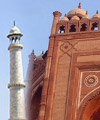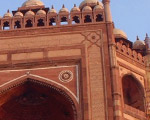|
Ayodhya
Ayodhya was amongst the first pilgrimage destination that I covered
during my stay in Uttar Pradesh.
The very first pilgrimage destination in Uttar Pradesh that I covered
was Ayodhya. Travelling in Ayodhya was not a problem since it is
located in center of the state of Uttar Pradesh, in the northern
region of India. Ayodhya is 130 km east of Lucknow and 6 km from
Faizabad.And since I was new to the place, I had to take guide who
could help me out in my venture. He told me that the best time to
visit Ayodhya is winters from November-February.
Being a net freak, I founded a cyber cafe that helped me to know
the ancient city of Ayodhya. One of the site vividly described Ayodhya
and its history. The site narrated "According to the Ramayana,
was founded by Manu, the law-giver of the Hindus. For centuries
it was the capital of the decendants of the Surya Vansh of which
Lord Rama was the most celebrated king. Ayodhya during ancient times
was known as Kosaldesha. The Atharvaveda describes it as "a
city built by gods and being as prosperous as paradise itself".
The illustrious ruling dynasty of this region were the lkshvakus
of the Surya Vash. Accoridng to tradition lkshvaku was the eldest
son of Vaivasvata Manu, who established himself at Ayodhya."
No doubt! it was a wonderland that we experienced during our stay.
Our guide took us to the most fascinating places of Allahabad -
babri masjid and Ram Janambhoomi. And Believe me I found each one
of them quite exotic.
Excursion
The Hanuman Garhi
Situated in the center of the town, this temple is approachable
by a flight of 76 steps. Legend has it that Hanuman lived here in
a cave and guarded the Janambhoomi or Ramkot. The main temple contains
the statue of Maa Anjani, with Bal Hanuman seated on her lap. The
faithful believe that all their wishes are granted with a visit
to this holy shrine.
A massive structure in the shape of a four sided fort with circular
bastions at each corner houses a temple of Hanuman and is the most
popular shrine in Ayodhya.
Kanak
Bhawan
Kanak Bhawan is one of the finist temple in Ayodhya. It was built
by queen of tikamgarh, virshbhanu kuvari in 1891. the main temple
is built around an opened inner court in which stands a small shrine
of Rampada . the main idols installed inside the garbhagriha are
of Devi Sit & Lord Rama . the sanctrum is well decorated .
Ramkot
The chief place of worship in Ayodhya is the site of the ancient
citadel of Ramkot which stands on an elevated ground in the western
part of the city. Although visited by pilgrims throughout the year,
this sacred place attracts devotees from all over India and abroad,
on `Ram Navami’, the day of Lord’s birth, which is celebrated
with great pomp and show, in the Hindu month of Chaitra (March-April).
Swargdwar
The strip of land from Sahasradhara to Nageshwarnath temple is commonly
denoted as Swargdwar. The buildings on the Ghat facing the river
were mainly built during the reign of Nawab Safdar Jung and his
Hindu minister Naval Rai, who is credited in in particular for their
construction. The buildings and the Ghats offer a fine view. In
recent years the river bed has shifted northwards, leaving the Ghats,
therefore the new Ghats were built around 1960 along with the new
bridge. The 'pairi' as it is popularly known offers an excellent
view from the bridge.
Mani Parvat
stands about 65 feet high and some scholars think it to be Buddhist
orgin. According to legends it was while Lord Hanuman was carrying
the hill bearning the Sanjeevani Booti (herb) for Lakshmans wounds
from Himalayas on way to Lanka a portion broke off and fell at Aydhoa
and this is that very mound.
Guptar
Ghat
contains a series of fine well - maintained ghats which were built
by Raja darshan singth in the 1st half of the 19th century. On top
of the ghats a palace was built which comprises a Sita -RAM temple
in the centre of the courtyard . the shrines of chakrahari and guptahari
exist here with a small narasimha temple.
Suraj Kund
3 km. from ayodhya is suraj kund, a large tank with ghats around
built by the rulers of surya vans hog ayodhya, as a homage to the
sun god. The spot os ideal for a calm and quiet holiday.
Mani Parbat and Sugriv Parbat
The first of these ancient earth mounds is identified with a stupa
built by the Emperor Ashoka, while the second is believed to be
an ancient monastery.
Treta ke Thakur
This temple stands at the place where Rama is said to have performed
the Ashvamedha Yajnya. About 300 years ago the Raja of kulu built
a new temple here, which was improved by Ahalyabai Hokar of Indore
during 1784, at the same time the adjoining Ghats were also built.
The initial idols in black sandstone were recovered from Saryu and
placed in the new temple, famous as Kaleram-ka-Mandir.
Nageshwarnath
Temple
The temple of Nageshwarnath is said to have been established by
Kush the son of Rama. Legend has it that Kush lost his armlet, while
bathing in the Saryu, which was picked up by a Nag-Kanya, who fell
in love with him. As she was a devotee of Shiva, Kush erected this
temple for her. It is said that this has been the only temple to
have survived till the time of Vikramaditya, the rest of city had
fallen into ruins and was covered by dense forests. It was by means
of this temple that Vikramaditya was able to locate Ayodhya and
the sites of different shrines here. The festival of Shivratri is
celebrated here with great pomp and splendor.
Other places of interest
Rishabhadeo Jain Temple, Brahma Kund, Amawan Temple, Tulsi Chaura,
Laxman Quila, Angad Tila, Shri Rama Janaki Birla Temple, Tulsi Smarak
Bhawan, Ram ki Paidi, Kaleramji ka Mandir, Datuvan Kund, Janki Mahal,
Gurudwara Brahma Kund Ji, Ram Katha Museum, Valmiki Ramayan Bhawan,
are among other places of interest in Ayodhya.
Top
Getting There
By Air
For Ayodhya the nearest airports are Amausi Airport (Lucknow-134
km), Bumrauli Airport (Allahabad - 166 km)
By Rail
Ayodhya is situated on the broad gauge Northern Railway line on
Mughal Sarai – Lucknow main route. Ayodhya/Faizabad are connected
to various parts of the country by the following trains:
2167/2168 – Saket Express (Bombay/Faizabad)
3307/3308 – Doon Express (Calcutta/Dehradun)
3151/3152 – Jammu Tawi Express (Calcutta)
3283/3284 – Ganga Yamuna Express (Bhiwani/Delhi-Varanasi/Danapur)
2449/2450 – Saryu Yamuna Express (Delhi/Varanasi)
9165/9166 – Sabarmati Express (Varanasi/Ahmedabad)
By Road
Connected by road to several major cities and towns. Some of the
major road distances are: Lucknow (134 km), Gorakhpur (132 km),
Jhansi (441 km), Allahabad (166 km), Sravasti (109 km), Varanasi
(209 km) and Gonda (51 km).
Top
General Information & Accomdation info on Ayodhya city of Uttar Pradesh - India
|






